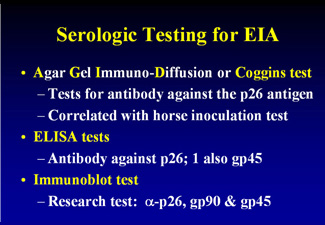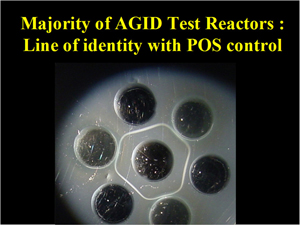TOPICS
- Home
- Challenges
- EIA Virus
- Transmission NEW!!
- Persistent Infection
- Pathogenesis
- Immune Response
- Diagnosis & Control
- Field Studies
- Publications NEW!!
- Links
- Contact and Credits
HOT TOPICS IN EIA RESEARCH
Diagnosis & Control
The diagnosis of EIA by clinical signs is not reliable. Laboratory tests for the presence of EIAV are available but rarely used because the most commonly used serologic test for antibodies, the agar gel immunodiffusion (AGID or Coggins) test, has been proven to correlate with virus presence. The horse inoculation test for EIAV using 250mls of whole blood is recognized as an official test for diagnosis of EIA by the USDA. The detection of EIAV genetic material by sensitive PCR or quantitative RT-PCR has proven to be a practical research tool but a less reliable indicator of field infections, because of the low volume tested or high genetic variability of the virus or both.
In addition to the AGID or Coggins test for detection of antibodies, a number of sensitive ELISA test kits are approved for use. The combined use of AGID and ELISA tests permit the highest level of sensitivity and specificity. The shortcoming of the AGID test is in samples with low levels of antibody which are difficult to interpret as positive, thus a false negative result may be reported. By contrast, the ELISA test formats require a lower level of antibody to produce a positive result that can easily be quantitated by machine, thus removing the subjective judgment of the technician. The shortcoming of the ELISA tests is that false positive results occur with higher frequency than in the AGID test. As only the AGID test results are correlated with EIAV presence, all ELISA positive samples must be confirmed by AGID before regulatory actions are taken. Rarely do results differ in AGID and ELISA tests; in those cases, a research immunoblot test can be used to determine the status. The immunoblot test uses whole purified virus with all virus structural proteins, so antibodies against multiple antigens can be detected. Thus, the power of the AGID test is greatest on positive samples and the power of the ELISA tests is greater on negative samples. By combining the strengths of both, more accurate diagnosis is possible.
As EIAV generally does not spread between horses without transfer of blood, control of EIA transmission can be effectively managed by testing and segregating test-positive from test-negative horses by a distance sufficient to break transmission by insect vectors, assuming humans are not contributing to transmission. This assumption deserves closer scrutiny after analysis of a recent outbreak in Ireland in 2006 concluded that at least 25 of the 28 cases of EIA in were in some way mediated by man. Even in areas of high vector pressure, 200 yard separation has proved adequate.
Unfortunately, the diagnosis of EIA sounds a death knell for the horse, as most owners cannot or do not wish to abide by mandatory quarantine restrictions placed by the appropriate regulatory body. In some states, safe quarantine is a screened stall at least 200 yards from other equids, and few opt for that. As no regulatory body offers monetary compensation for destruction of the positive horse, we are fortunate in that the majority of EIA cases diagnosed in the US were in the 1970's, when recovery of some cost for the loss of the horse was possible through slaughter.
Approximately 2,000,000 samples are tested for EIA annually in the US. There still remains a substantial number of equids that have eluded testing to date and that remain unquantified reservoirs of EIAV. One of the most effective ways to find new cases of EIA appears to be a required test at change of ownership. This form of surveillance testing not only protects the unsuspecting buyer but also effectively recruits additional equids into the tested portion of the population.
Please see the USDA interactive site link for data on EIA testing from 1972 to the present and the Laboratory Guides from 2003:
February 17, 2010

